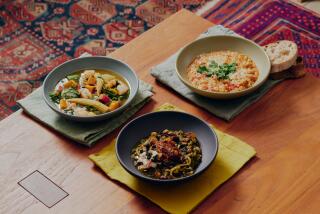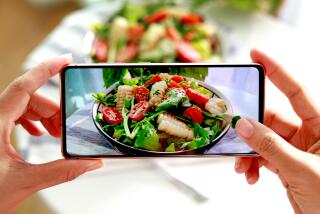Diet Poses a Problem for Cancer Patients : Modifications Often Necessary Because of Adverse Side Effects
- Share via
Dining often becomes a dreaded experience for many cancer patients receiving chemotherapy and radiation treatment.
Depending on the cancer, problems such as loss of appetite, chewing difficulties resulting from soreness and dryness of the mouth, intestinal upset accompanied by nausea and vomiting, as well as depression causing loss of appetite, can create nutritional havoc on the already afflicted health of the sufferer.
Shelly Huttar, chief clinical dietitian at Western Medical Center in Santa Ana, thinks that some of the problems can be overcome.
“Eating properly, even under adverse conditions, should be a high-priority goal for both cancer patients and the supportive families,” Huttar said. “The reason it’s important to eat well when one has cancer is to maintain strength and prevent body tissue from breaking down.”
Diet Changes Needed
Although eating a well-balanced diet including foods from the four food groups (fruits/vegetables, meats, dairy products and grains) applies to cancer patients as well as to those who are healthy, modifications in the diet are necessary because of the adverse side effects of drug or radiation treatments, which cause the patient’s intolerance to certain foods.
One of the goals of dietitians dealing with cancer patients is to get the patient to eat enough protein. “A high-protein diet enhances the response to radiation treatment, and an adequate intake of calories spares protein for building cells. Besides, patients must have a good protein intake in order to be considered candidates for chemotherapy,” Huttar said.
Most patients have a problem eating red meat or chicken, Huttar points out. “I often suggest eating dairy products as substitutes because of the importance of including protein in the diet,” she said. If the patient is intolerant to milk, other dairy products, such as cottage cheese, ice cream, cheese and yogurt, can be substituted.
Hints on how to cope with special problems arising from cancer treatments are discussed below. Most problems can be alleviated, depending on the individual and his or her particular problem.
Helpful Sources
Help with diet can be sought from many sources, including most major private and university-based hospitals with both in- and outpatient cancer programs. Many government publications, provided through the U.S. Department of Agriculture Printing Office or a government bookstore in your area, are available free of charge or at nominal cost. Consumers may also write for a catalogue of publications to Consumer Information Center, Dept. 532 G, Pueblo, Colo 81009.
For answers to any questions you may have about cancer, call the toll-free hot-line number, 1-800 4-CANCER, operated by the Cancer Information Service of California and sponsored by the National Cancer Institute. Hot-line operating hours are Monday through Friday 9 a.m. to 4:30 p.m.
Publications recommended by the NCI are sent free of charge to individuals requesting them.
One such NCI publication, “Eating Hints: Recipes and Tips for Better Nutrition During Cancer Treatment,” provides invaluable dietary tips, recipes and ideas for making meals more palatable for the cancer patient. Here are a few tips garnered from the publication.
On increasing protein in the diet: One can add protein to the diet without increasing the amount of food eaten. Here is how:
--Skim milk powder adds protein to the diet. Add two tablespoons dry skim milk powder to regular amount of milk in recipes.
--Use fortified milk for cooking and drinking (see double-strength milk recipe below).
--Add milk powder to hot or cold cereals, scrambled eggs, soups, gravies, ground meats (patties, meatballs and meat loaf), casserole dishes, desserts and in baking.
--Use milk or half and half instead of water when making soup, cereals, instant cocoa, puddings and canned soups. Soy formulas may also be used.
--Add diced or ground meat to soups and to casseroles.
--Add grated cheese or chunks of cheese to sauces, vegetables, soups and casseroles.
--Add cooked cubed shrimp, canned tuna, crab meat, diced ham or sliced boiled egg to sauces. Serve over rice, cooked noodles, buttered toast or hot biscuits.
--Choose dessert recipes that contain eggs, such as spongecake, angel food cake, custard, bread pudding or rice pudding.
--Add peanut butter to sauces, on crackers, waffles or celery sticks.
On adding calories to the diet:
--Mix one teaspoon (45 calories) butter or margarine to foods such as soups, vegetables, mashed potatoes, cooked cereal and rice. Serve hot bread with more butter than used normally.
--Use mayonnaise, which contains 100 calories per tablespoon, in salads, on eggs, on lettuce in sandwiches.
--Use peanut butter (90 calories per tablespoon) on celery and such fruits as bananas and pears. Add it to a sandwich with mayonnaise or cream cheese.
--Spread honey (64 calories per tablespoon) on toast and use as a sweetener in coffee or tea and on cereals.
--Use sour cream (70 calories per tablespoon) or yogurt (16 calories per tablespoon) on vegetables, such as potatoes, beans, carrots or squash. Add to gravies or as salad dressing for fruit. Use sour cream as dip for vegetables or add a dollop to a split banana.
--Add whipping cream (60 calories per tablespoon) to pies, fruit, puddings, custards, gelatin desserts and hot chocolate.
--Add marshmallows to fruit or hot chocolate.
--Keep snacks such as nuts, dried fruits, candy popcorn, crackers, cheese, granola, ice cream and fruit ice pops handy at all times.
--Try milkshakes for a high-calorie snack.
--Add powdered coffee creamers to gravy, soup, milkshakes and hot cereals for extra calories without volume.
--Add extra calories by breading meat, chicken and fish.
--Add raisins, dates, chopped nuts and brown sugar to hot cereals or to cold cereals for a snack.
On alleviating diarrhea:
--Avoid foods containing high fiber such as bran or cereals and breads, certain raw fruits and vegetables. Even the normal amount of fiber may be too much for intestines if they are irritated.
--Use only cooked fruits and vegetables, omitting those with seeds and tough skins.
--Avoid beans, broccoli, corn, onions, garlic, breads and nuts.
--Potassium, an important element that is lost in great quantities when one is afflicted with diarrhea, should be replaced by eating some foods that are high in potassium, such as bananas, apricots (low-fiber fruits), peach nectar, fish, potatoes and meat. If consuming these foods poses a problem, consult your physician about taking potassium supplements.
--If cramps ensue, avoid foods that encourage gas or cramps, such as carbonated drinks, beer, beans, cabbage, broccoli, cauliflower, highly spiced foods, too many sweets and chewing gum.
--Avoid fatty foods and highly spiced foods.
--Eat smaller amounts of food more often.
--Drink liquids between meals instead of with them. Drink plenty of liquids since diarrhea causes loss of fluids and salt, which must be replaced.
--Avoid milk or milk products until diarrhea has stopped.
Conversely, for constipation problems resulting from treatment with some drugs:
--Increase intake of fibrous foods such as fruits and vegetables, whole-grain breads and cereals, dried fruits (raisins, prunes and apricots) and nuts. Grate these foods if chewing or swallowing is a problem.
--Add one or two tablespoons bran to casseroles, cereals, eggs and baked goods or eat as a raw cereal.
--High-fiber snack foods, such as sesame bread sticks, date nut bread, oatmeal cookies, fig newtons, date or raisin bars, granola, prune bread and corn chips can be added to the diet.
--Drink plenty of liquids--eight to 10 full glasses each day.
--Hot liquids such as prune juice or hot lemon water taken in the morning or at night often help stimulate bowel activity.
--Light exercise, such as walking, will sometimes help constipation.
On bloatedness:
Certain foods may contribute to the production of air in the stomach or intestines to cause a feeling of being bloated. Less exercise than usual may also play a role. In addition, nervousness or rushed meals may cause one to swallow air as one eats.
Here are some tips for alleviating the bloated feeling:
--Eat foods that are easily digested, especially those that are bland and low in fat.
--Avoid foods that may cause gas, such as onions, garlic, broccoli or foods in the cabbage family.
--Try eating more slowly, counting to 10 while chewing each mouthful.
--Stop eating when you feel uncomfortable.
--Take a walk or get some exercise.
On heartburn:
--Use mildly seasoned foods.
--Avoid fried, greasy or heavily spiced foods.
--Frequent, smaller meals move through the stomach quickly and help prevent heartburn.
--Do not lie down for two hours after eating.
--When in bed, elevate the head of the bed four inches.
--Take liquid antacids one and three hours after meals, at bedtime and upon awaking in the middle of the night. Keep the liquid antacid chilled for better taste.
When chewing is difficult, patients tend to eliminate many important food categories, creating a climate of nutrient inadequacy. “All foods in your daily guide are needed,” advises a booklet called “Nutrition for Patients Receiving Chemotherapy and Radiation Treatment,” published by the American Cancer Society. Here are some tips from the booklet:
--Cut meat or chicken into small pieces and combine them with potatoes, cooked vegetables, rice or noodles.
--Meat may be ground and broiled or used as a base of a hearty soup, stew or fricassee.
--Fish is easy to eat when baked or broiled and flaked to add to sauces, soups and casserole dishes.
--Cottage cheese, another easy-to-eat food, may be eaten plain or mixed with fruit or cooked vegetables.
--Soups may be made from dried beans or peas for added protein value. Another protein booster in soups can be egg dropped into hot soup and mixed.
--Cooked fruits and vegetables may be chopped, mashed or, if necessary, strained. Many fruit and vegetable juices, canned and frozen, are on the market.
--Any kind of cooked cereal may be eaten. Ready-to-eat cereals and toast may be soaked in milk. Cereals may be cooked in milk instead of water for added food value.
--Gelatin, ice cream and soft cakes also may be enjoyed.
--Milk is a good drink as is, but also can be added to soups, cream sauces, scalloped dishes, puddings and custards.
--Strained baby food can be tried for a very soft diet. Strained meat, chicken and vegetables can be added to soups for extra flavor and food value. For instance, add strained chicken to cream of celery soup.
--Raw fruit such as bananas, peaches, pears and oranges will add variety to meals.
--A blender may be a good investment for someone requiring a very soft or semi-liquid diet.
--Double-strength milk, made by adding one cup dried skim milk to one quart fluid whole milk (instead of to water), will provide about twice as much protein as one cup of whole milk or skim milk.
--To double-strength milk, add flavorings such as strawberry or raspberry syrup, vanilla or coffee extracts, molasses or maple syrup, mashed bananas, apricots, peaches or other fruit purees and juices.
--Double-strength milk can also be added to cooked foods, such as cream soups, cereals made with milk instead of water, custards, puddings, cocoa, creamed foods, meat loaf and mashed potatoes.
Problems with nausea and vomiting caused by chemotherapy and radiation can be diminished with some dietary modifications. A booklet called “Eating Hints: Recipes and Tips for Better Nutrition During Cancer Treatment,” published by the U.S. Department of Health and Human Services of the National Institutes of Health provides the following advice:
--Ask your doctor to prescribe anti-nausea medicine and take this medicine 30 to 60 minutes before eating.
--Smaller portions of foods that are low in fat help because they are easier to digest and travel through the stomach faster.
--Eat salty foods and avoid overly sweet ones, especially if you have been vomiting.
--Eat dry foods, such as toast or crackers, especially after rising in the morning.
--Cool, clear beverages, clear soups, flavored gelatin, carbonated beverages, fruit-flavored ice pops, and ice cubes made with juices are recommended.
--Sip liquids slowly through a straw.
--Avoid liquids at mealtimes. Take liquids 30 to 60 minutes before eating to avoid the feeling of being full.
If food odors are a problem, follow these tips:
--Let someone else do the cooking.
--Sit in another room or take a walk while food is being prepared.
--Avoid foods or beverages that produce this effect, such as brewing coffee.
--Avoid greasy foods or fried foods.
--Use prepared foods from the freezer that can be warmed at a low temperature or a meal that does not have to be cooked.






